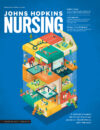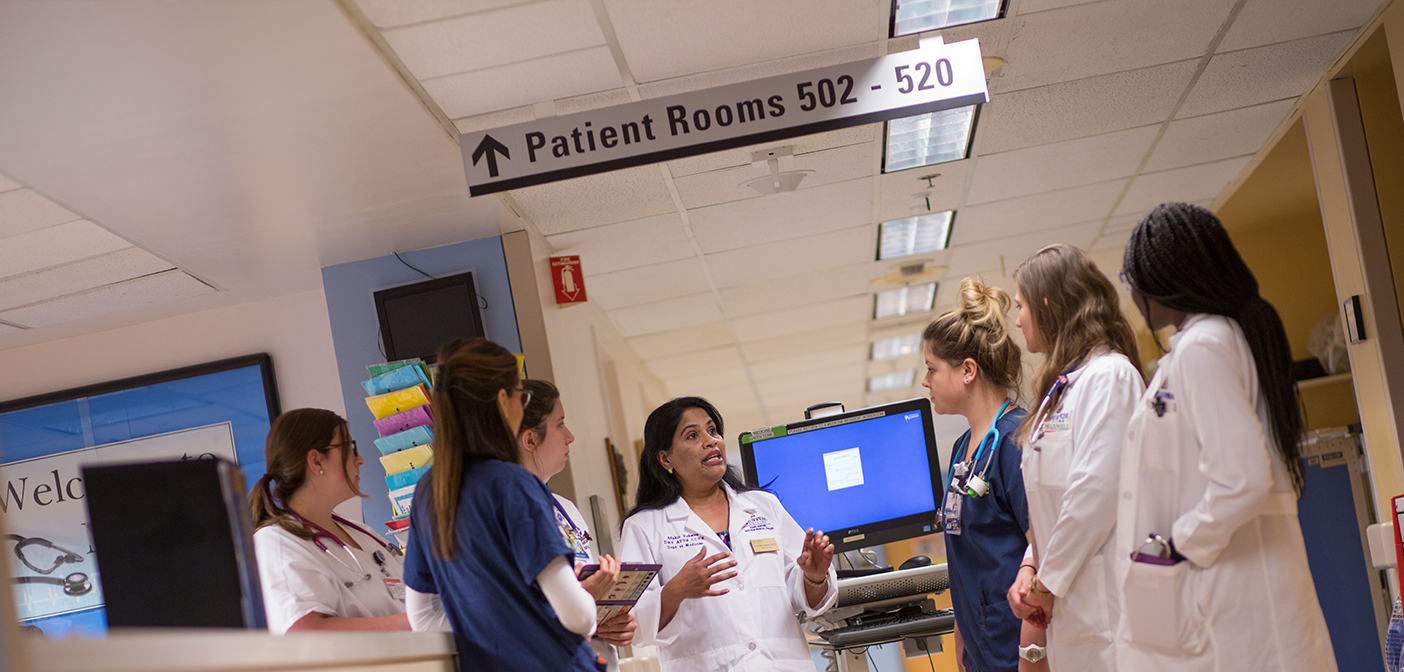The nurse attending position at Johns Hopkins Bayview Medical Center is transforming patient care.
Photos by Chris HartloveWhen Alphie Rahman, DNP, APRN-CNS, makes her rounds at Johns Hopkins Bayview Medical Center, the nurses are eager to join her.
Rahman, a clinical nurse specialist and nurse attending for Johns Hopkins University, fulfills a special role educating nurses and doctors as well as improving patient satisfaction. As a nurse attending, she teaches medical professionals to communicate better and emboldens nurses to share their unique perspective on patient care.
The problem in typical hospital settings, Rahman says, is that the patients’ health care team members often aren’t all on the same page.
“We work in silos,” she explains. “For example, when doctors change a patient’s medication, nurses aren’t involved, so the nurse doesn’t have any clue why it was changed. The patient doesn’t know, and the nurse has no answer for them.”To change that silo mentality, Johns Hopkins Bayview created the nurse attending position in 2016 to help doctors and nurses work together more efficiently. The model is an extension of the Aliki Initiative, a program established in 2007 by the Johns Hopkins Center for Innovative Medicine that emphasizes patient-centered care. In this curriculum, medical students and residents learn to tailor treatments to each patient’s specific needs.
“We work in silos. For example, when doctors change a patient’s medication, nurses aren’t involved, so the nurse doesn’t have any clue why it was changed. The patient doesn’t know, and the nurse has no answer for them.”
— Alphie Rahman, DNP, APRN-CNS
“Dr. Rahman models interprofessional collaboration for nurses and students alike,” explains Elizabeth “Ibby” Tanner, PhD, RN, FAAN, director of interprofessional education for the Johns Hopkins schools of Nursing and Medicine. “This role is making a difference in improving teamwork and patient outcomes and serves as an example for improving team-based care.”Adding the nurse attending position facilitates communication with nurses and helps them understand a nurse’s role as the patient’s closest caregiver.
“As nurses, we are at the bedside 24 hours a day,” says Natalie Davis, a nurse in Medical Unit B. “Doctors are looking at objective data, numbers, lab values, and protocols. But patients are unique, and we have to individualize care plans to meet their needs.”Davis usually has at least one patient assigned to the Aliki team, which includes two interns, two residents, two medical students, one medical attending, and Rahman, the nurse attending. When the team rounds on one of her patients, Davis gets a call to join them. With everyone in the same room, doctors update nurses and patients at the same time. Nurses who are often more familiar with the patient can ask questions and make recommendations.
“Sometimes there are orders that don’t make sense,” Rahman says. “If the nurse isn’t comfortable with any procedures or intervention, she educates the team at that time.”
Davis, who has been a nurse for two years, says she’s trying to become more comfortable raising concerns and asking for rationale from providers. Rahman makes a point to ask for the bedside nurse’s input, which boosts Davis’ confidence and acknowledges her vital role in patient outcomes and satisfaction.
“Seeing the nurse attending at the bedside empowers nurses to speak up,” says Dianne Campo, a charge nurse at Johns Hopkins Bayview. “Alphie gives them cues to ask questions they typically wouldn’t ask. It helps them be better patient advocates.”
Davis recalls a time when she disagreed with a prescribed medication.
Olutomi Sodeke, MD, and Natalie Davis, RN. “The medication concerned me for that patient’s situation,” she says. “I can ask for rationale, and you get the explanation, so it’s a good learning experience. In that case, they ended up canceling the medication. It would have had a bad interaction for the patient.
“Nurses think one way, and doctors think a different way. We bring different points of view to the table. I feel like the doctors are learning a lot, too.”Rahman would love for each rounding team to have a nurse attending, but budgets can’t cover the cost. Still, teams rotate every two weeks, so new students, interns, and residents get to experience the Aliki model with a nurse attending present.
“My hope,” she says, “is that what they learn from this team and interprofessional experience, they will carry that with them.”

